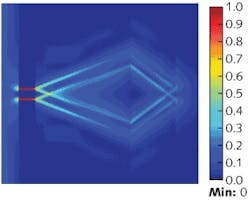Gold- and silver-free metamaterial shows negative refraction in the near-IR
West Lafayette, IN--To create an alternative to the use of silver and gold in metamaterials, researchers at Purdue University, the Russian Quantum Center (Moscow, Russia), and DTU Fotonik, Technical University of Denmark (Lyngby, Denmark) have replaced the noble metals with aluminum-doped zinc oxide (AZO), resulting in a metamaterial that experimentally demonstrates negative refraction in the near-IR.
Using the metals is impractical for industry because of high cost and incompatibility with semiconductor manufacturing processes. The metals also do not transmit light efficiently, causing much of it to be lost. The Purdue researchers replaced the metals with an "aluminum-doped zinc oxide," or AZO.
"The doped oxide brings not only enhanced performance but also is compatible with semiconductors," said Alexandra Boltasseva, a Purdue University assistant professor of electrical and computer engineering.
Purdue doctoral student Gururaj Naik provided major contributions to the research, working with a team to develop a new metamaterial consisting of 16 layers alternating between AZO and zinc oxide. Light passing from the zinc oxide to the AZO layers encounters an extreme anisotropy, causing its dispersion to become hyperbolic, which results in negative refraction.
Research findings are detailed in a paper appearing today (May 14) in the Proceedings of the National Academy of Sciences. The list of possible applications for metamaterials includes a planar hyperlens that could make optical microscopes 10 times more powerful and able to see objects as small as DNA; advanced sensors; more efficient solar collectors; quantum computing; and cloaking devices (see figure of an earlier planar hyperlens design of silver and silicon dioxide developed at Purdue).
The AZO also makes it possible to "tune" the optical properties of metamaterials, an advance that could hasten their commercialization, Boltasseva said. "It's possible to adjust the optical properties in two ways. You can vary the concentration of aluminum in the AZO during its formulation. You can also alter the optical properties in AZO by applying an electrical field to the fabricated metamaterial."
This switching ability might usher in a new class of metamaterials that could be turned hyperbolic and non-hyperbolic at the flip of a switch.
"This could actually lead to a whole new family of devices that can be tuned or switched," Boltasseva said. "AZO can go from dielectric to metallic. So at one specific wavelength, at one applied voltage, it can be metal and at another voltage it can be dielectric. This would lead to tremendous changes in functionality."

John Wallace | Senior Technical Editor (1998-2022)
John Wallace was with Laser Focus World for nearly 25 years, retiring in late June 2022. He obtained a bachelor's degree in mechanical engineering and physics at Rutgers University and a master's in optical engineering at the University of Rochester. Before becoming an editor, John worked as an engineer at RCA, Exxon, Eastman Kodak, and GCA Corporation.
